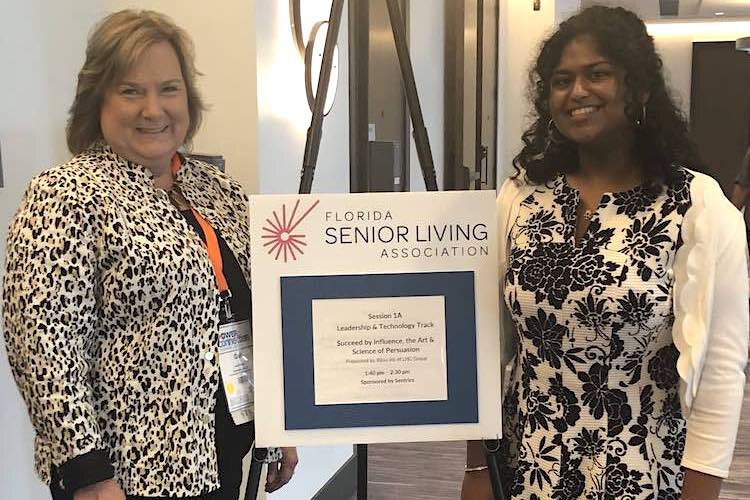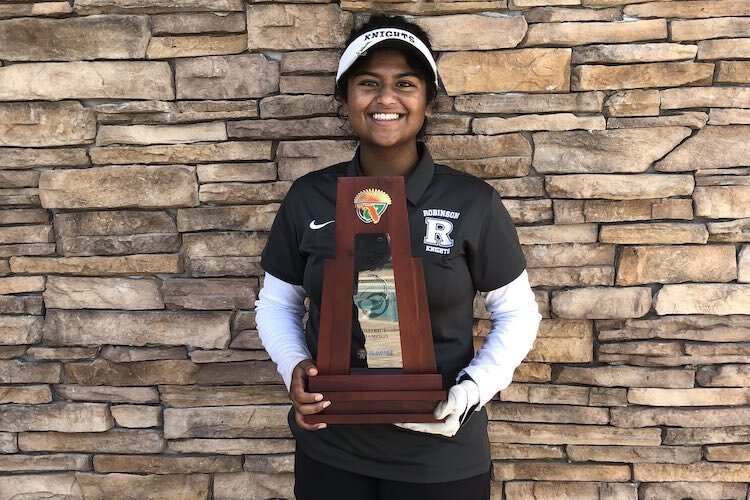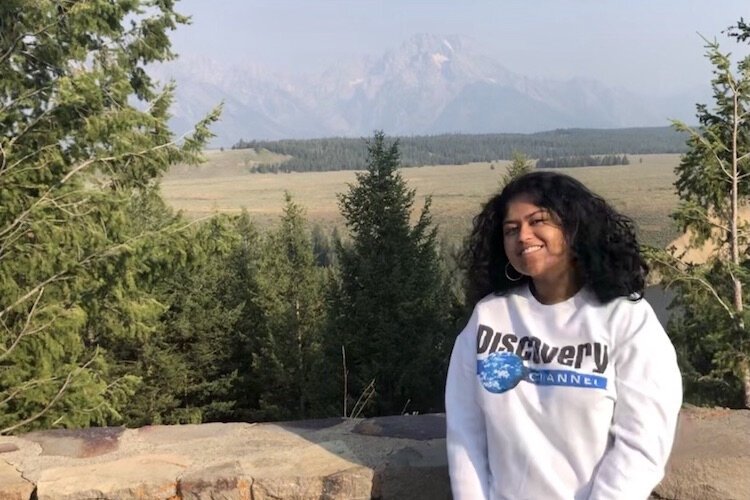Tampa teen entrepreneur combines compassion, music to enhance the quality of life in senior centers
PriyaFM intertwines a compassionate nature and love of singing to uplift the lives of people in senior living centers around the country.
Have you ever heard a song that transcended your mind to a place buried deep in your memory? Perhaps your wedding song, a song from your first live concert, or the first time you heard your favorite artist play a new hit on the radio?
Sometimes just hearing the beginning of a song that you and your first love called “your song” can fill your eyes with tears or bring a smile. Those feelings prompted by music flowing from your ears to your heart can change your mood or even shape how your day goes.
But how and why does that happen? And how can that natural phenomenon be used to help people?
That was the thought process that inspired Tampa native and Robinson High School student Priya Sambasivan, 17, to recognize the opportunity to put her musical talent to work for good by creating PriyaFM, her latest venture.
PriyaFM is an interactive, virtual singalong in which members of senior living communities across the country can join Sambasivan in experiencing the art of music. The singalongs happen via Zoom calls, accounting for health and safety protocols in the midst of the COVID-19 pandemic, and allowing for easier access and more participation nationwide.
From a personal standpoint, Sambasivan wanted to combine her interests of singing and helping others to create a program in which senior citizens who also enjoyed music could participate and share with her.
Music “is my favorite pastime, favorite method of relaxation, and now it’s my favorite way to help people,’’ she says.
Her original vision of in person singalongs was nearly finalized prior to the pandemic. When the quarantine began, PriyaFM was brought to a halt, so she weighed her options and decided to take the concept into a virtual space. That adaptation was a crucial factor in her expansion, since she realized that making her singalongs virtual meant she could reach more people.
Targeting loneliness
Sambasivan says she pays heavy attention to detail when formatting her singalongs and compiling her list of music for each session. The main goal is to eradicate that overwhelming sense of loneliness that accompanies many members of senior living communities, especially during the pandemic, and to create nostalgia for the members.
This nostalgia first brings familiarity to the singalong session, and breaks the ice for Sambasivan and participants to connect under a commonality of familiar Jazz songs. The singalongs are interactive, so songs that are well-known and memorable to an older demographic are within the lineup. The nostalgia isn’t just for entertainment purposes, but for positive impacts on the mental health of the participants.
Sambasivan begins each session by giving a run down of her week and conversing with the seniors, then she introduces the first song. Her song selections carry a backstory and she reveals a little about that before she begins to establish the initial emotion that encompasses each song included in the program.
The circumstances in which Sambasivan first heard a particular song will differ from nearly all of the other participants, as well as the participants’ stories differentiating from other members of the group. This initiates the emotional aspect of music and what the singalongs can do. Sambasivan emphasizes that “the interaction is just as important, if not more important, than the music itself.”
The songs Sambasivan selects for her senior contacts are jazz songs from the 20th century, anywhere from the 1920s to the 1960s, a broad range that offers a wide variety. From a psychological standpoint, having such a broad range in songs can bring back memories from different time periods in each of the members’ lives. This can spark emotions and feelings that have been buried over the years, and opens the door for discussion among the group of why those songs resonate and what the song emotionally means to each person.
Sambasivan can then discuss with the seniors why each song may have special meaning, or how that song might not be their favorite. There is always a backstory to music that includes the times you’ve heard the songs, who you have heard the songs with, what your life looked like when you heard that song, and what the song can say on your behalf when you cannot utter the words yourself.
Once she began receiving requests from senior living centers to schedule singalongs, she decided to call the activity PriyaFM — FM to represent a radio station, as radio stations are live but not in person, just like the singalongs. Sambasivan tries to be interactive and get to know the people she’s serving, just like a radio host would talk and converse with listeners who phone in.
Although Sambasivan’s research on how music affects the mind and spirit came secondary from her entrepreneurial efforts, it provided confirmation that what she’s doing is having a positive impact on those in senior living communities.
Just as communication connects different people in different ways, music is a mode of communication that is not limited by language barriers, or even a differing opinion on how particular songs make each of us feel. The commonalty in music is that we can all listen and interpret it together, even if those interpretations and opinions differ. Appreciating the art form for what it is and the quality of collectiveness that it brings to communities is the beauty in the art.
Triggering memories
People began responding extremely well after her first few singsong sessions, Sambasivan says, making her wonder if there was more to the science behind her singalongs. In her research, she discovered there are major benefits for people who have dementia to hear music from their youth that can trigger memories from their past.
“Musical connections in your brain are different than standard memory or statistical connections that your brain makes, so I would love to research that more,’’ Sambasivan says. “By looking at the research, I can find ways to make my program more beneficial for people, and alter it to help make the experience better overall. I’m always about improvement.”
Her singalongs, she says, have more of a philosophical and scientific impact than she originally foresaw.
Music creation and observation was originally seen as an activity for the elite and those in academia looking at traditional and classical music.
Now she knows that the way we listen to and interpret music is an integral part of ourselves and how we communicate with those around us.
Modern music has evolved into experimental and abstract forms that greatly differ from traditional sounds of music, nevertheless, have had an immeasurable impact on the art.
A study published in Frontiers in Psychology observed that musical perception “improves cognitive skills such as fluency, working memory, and recognition memory.” The same study revealed that “musical production could have even more beneficial effects than musical perception.”
This means, not only does hearing these songs help improve the cognitive abilities and moods of those who participate, but having them actively participate in the audible creation of music takes this mental exercise a step further.
Sambasivan is engaging with senior living community members for her own enjoyment, to reduce the sense of loneliness they may feel, and to connect with others who share her common interests, despite age and location. Through PriyaFM, she aims to improve lives by regularly exercising their cognitive skills, memory, and enhancing their moods, which have the ultimate affect on how productive and happy they are.
Sambasivan’s propensity toward music was evident as a toddler, her parents say. When she was about 10 years old, she began training her voice in a serious setting at the Leopold School of Voice and Piano in Tampa.
While her latest endeavor reflects her interests in all things art, design, and humanities, she also has a deep appreciation for the natural sciences and technology. In elementary school, she began her own custom greeting card company and built her own website for it. From third-grade through seventh-grade, Sambasivan participated in CoderDojo Tampa Bay, a coding class offered by the Tampa-Hillsborough public libraries. As she got older, she transitioned from student to mentor at CoderDojo. As a rising high school student, she earned certifications in HTML and CSS, Dreamweaver, and other Adobe softwares.
PriyaFM is currently active in six senior living centers in six states, and she says she “only has 44 more to go!” Sambasivan would like to connect different locations together to make it more interactive and inclusive. “It’s important to be reminded how big the world is.”
Here is a list of senior living centers now served by PriyaFM
- Brookdale Hillsborough, New Jersey
- Caslen Living Centers, Montana
- Brookdale Westlake Village, Ohio
- Brookdale Palm Beach Gardens, Florida
- Brookdale Chambrel, Williamsburg, Virginia
For more information, visit the PriyaFM website.
















